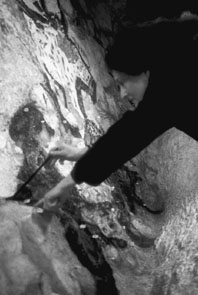

 | Page 793 |  |
In 1865 he became a member of the Société d’Anthropologie de Paris, and in 1869 its president and professor of paleontology at the National Museum of Natural History. Ill health caused his early retirement from both these positions.
See also
References
Wangernez, J. 1986. Édouard Lartet, 1801–1871: “Le Gersois Fondateur de la Paléontologie Humaine.” Le Mois Scientifique Bordelais 66: 1–3.
Lascaux, a cave occupied during the Magdalenian period in the Dordogne region of france, was discovered by four boys in 1940, and it remains among the most spectacular collection of Paleolithic wall art yet found. It is best known for its 600 magnificent paintings of aurochs (wild cattle), horses, deer, and signs of various kinds, but it also contains almost 1,500 engravings dominated by horses. The best-known feature is the great Hall of the Bulls, which contains several great auroch figures, some of them five meters in length, the largest figures known in Ice Age art. The hall also contains an enigmatic figure, called “the unicorn.” A shaft features a painted scene of what seems to be a bird-headed man with a wounded bison and a rhinoceros, and the scene has often been interpreted in shamanistic terms, though with little justification.

Archaeologist exploring Lascaux Caves
(Gamma)
Stone tools for engraving were found in the cave as well as many lamps, 158 fragments of pigment, and color-grinding equipment. Scaffolding was clearly used in some galleries to reach the upper walls and ceiling. Much of the cave floor was lost when the site was adapted for tourism, but it was probably never a habitation—it is more likely it was visited only briefly for artistic activity or ritual. Charcoal fragments from the cave floor have provided radiocarbon dates around 17,000 years ago and in the ninth millennium b.p.
The cave was closed to tourists in 1963 because of pollution that resulted in a “green sickness,” consisting of a proliferation of algae, and a “white sickness” of crystal growth. It was possible to reverse the effects of the green sickness and arrest the development of the white, but to ensure the survival of the cave’s art, the number of visitors had been drastically reduced. As compensation, a facsimile cave, a complete copy of the original cave and its details, Lascaux 2, is now open nearby.
See also
For a long time after World War II the traditional subdivision of time concerning the investigation of the history of archaeology in the main publications and surveys (Moora 1952; Graudonis 1967; Šnore 1974) was into four periods. This division is based on the political situation in the Baltic states during the eighteenth through the twentieth centuries. The first period of archaeological study, from the middle of the
 |  |